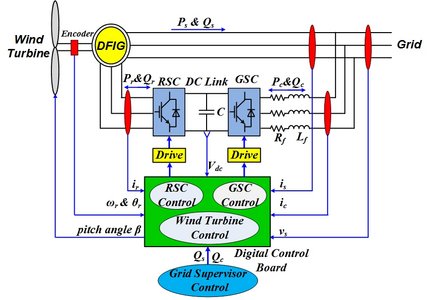Design of Sensorless Control and Low Voltage Ride-Through Strategy for Doubly-Fed Induction Generator Based Variable Speed Wind Turbines
Research Focus
This project aims to design a sensorless control and a low voltage ride through strategy for the doubly-fed induction generator, which considered one of the most popular generators in variable speed wind turbines applications.
Contact
Introduction
Wind energy is considered nowadays one of the most widely installed renewable energy resources (RERs) in the world and especially in Europa. Most of the major wind turbines manufactures are developing new large scale wind turbines based on variable speed wind energy conversion (VSWEC) technology with pitch control using either double-fed induction generator (DFIG) with partial scale back to back (B2B) voltage source converter or permanent magnet synchronous generator (PMSG) with full scale B2B voltage source converter. The DFIG technology is more economically viable than PMSG as it implements a B2B voltage source converter rated at 30%–35% of the generator rating for a given rotor speed variation range of ± 25% .
The DFIG-based wind generator system, Fig.1, consists of six parts: the wind turbine system (mechanical part), the DFIG generator, the rotor side converter (RSC), the DC link, the grid side converter (GSC) and its filter, and the control system. The control system is divided into three parts: RSC control, GSC control, and wind turbine control.
The DFIG is used as a variable speed generator in standalone and grid connected applications. In both cases, the use of sensorless control is desirable because position encoders or speed transducers have many drawbacks in terms of maintenance, cost, robustness, and cabling between the speed sensor and controller. Moreover, with the increasing integration of wind power into power grids, many requirements for wind power plants have been added in the new grid codes (GCs). According to these grid codes, three requirements are the most common for the wind farms: active power and frequency control, reactive power and voltage control, and low voltage ride through (LVRT) capability.
The LVRT requirement demands wind power plants to remain connected when a grid voltage dip occurs, thus contributing to maintaining stable network voltage and frequency by delivering active and reactive power to the grid with a specific profile depending on the grid-voltage dip depth. Hence, LVRT is probably the most challenging requirement among the GCRs, at least from the point of view of the WECS.
The WECS based on DFIG and partial scale B2B voltage source converter with pitch control is
shown in Fig.1. This project aims to:
- Development of RSC control, which will achieve:
- Independent control of active and reactive power injected to the grid.
- Maximum power point tracking (MPPT) to maximize the power generation of the wind turbine (for wind speeds below the nominal wind speed).
- Development of GSC control, which will achieve:
- Fast and accurate set-point tracking of the DC-link voltage during all operating conditions.
- Control the reactive power exchange between the grid and the GSC.
- Development of speed observer instead of using mechanical sensors or encoders.
- Development of wind turbine control, which control of the pitch angle of the wind turbine
(for wind speeds higher than the nominal wind speed).
- Development of LVRT strategy for the DFIG which will achieve the following:
- Protection of the DFIG and the back-to-back converter during grid disturbances.
- Injection of active and reactive power to the grid during and after the fault to assure/support stable operation and to help to restore the healthy state of the grid.
